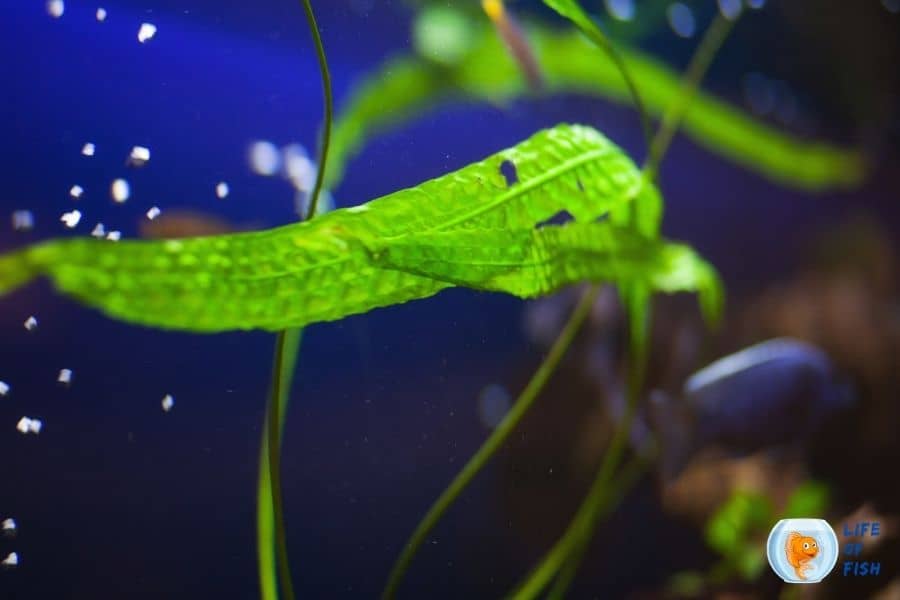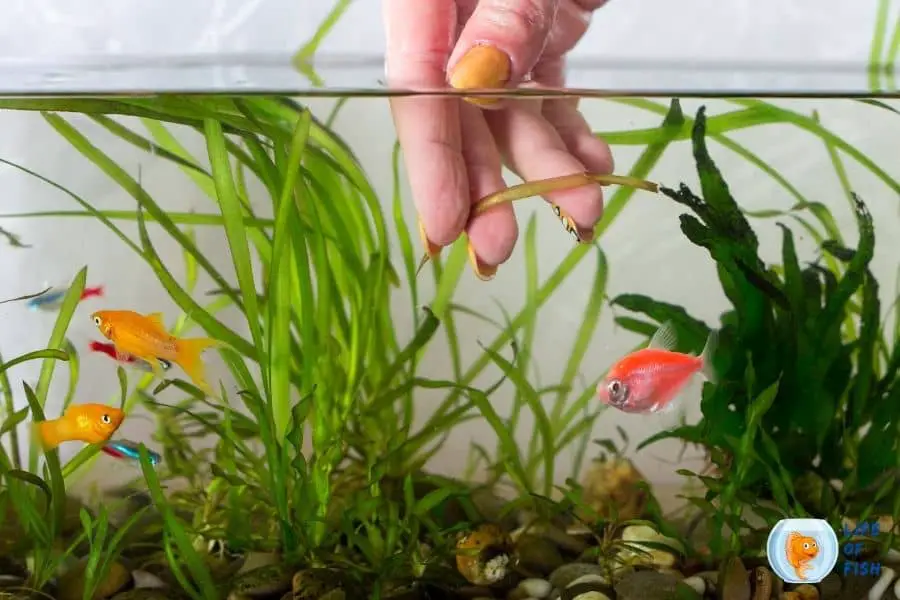Hydrogen peroxide is a perfect cleaning agent to sterilize fish tanks, ornaments, and live plants. Also, it is a harmless chemical. But do you know how To Clean Aquarium Plants With Hydrogen Peroxide?
I will explain how to use below methods to clean your aquarium plants in this article.
- Treating procedure of the aquatic plants within the tank
- Treating procedure of the aquatic plants using the dip method
- Inject hydrogen peroxide

Why Should You Clean Your Aquarium With Hydrogen Peroxide?
Jump To
- 1 Why Should You Clean Your Aquarium With Hydrogen Peroxide?
- 2 Pre preparation tips before cleaning with Hydrogen Peroxide?
- 3 How To Clean Aquarium Plants With Hydrogen Peroxide?
- 4 How Does Hydrogen Peroxide Work?
- 5 Will Hydrogen Peroxide Kill Aquarium Plants?
- 6 How Long Do You Dip Aquarium Plants In Hydrogen Peroxide?
- 7 Does Hydrogen Peroxide Get Rid Of Algae?
- 8 Safety Precautions
- 9 Conclusion
Hydrogen peroxide is a colorless liquid chemical. Moreover, this compound is similar to water. It is made with two hydrogen molecules and two oxygen molecules, and its molecular formation is H2O2. There is some major reason why you select hydrogen peroxide to clean algae besides other chemicals. I mentioned these reasons in detail in the below sections.
Safely Remove Algae From The Aquarium And Equipment
Algae growth is a significant problem that associates with the aquarium industry. Hydrogen peroxide is an ideal chemical that can use to overcome this issue. Moreover, it is a harmless cleaning agent. Further, it converts to water and oxygen within 24 hours under sunlight. Thus, you can use H2O2to sterilize your fish tanks, glasses, pipeworks, and plastic Ornaments. Further, you can use an intense concentration (1 part H2O2 to 10 parts water) to clean algae from glassware and ceramic ornaments.
Quickly Remove Algae
Hydrogen peroxide can remove algae quickly from the glasses.
Remove Pathogenic Bacteria And Virus
Their antibacterial and antifungal properties help to remove pathogenic bacteria and viruses from the tank. Generally, the 3% hydrogen peroxide can kill pathogens and algae spores at a concentration of 1 part H2O2 to 150 parts water.
Increase The Oxygen Level Of The Fish Tank.
Hydrogen peroxide not only cleans algae and bacteria but also increases the oxygen level of the tank. It can break down to water and oxygen within 24 hours under sunlight. It causes to increase in the oxygen level of the tank.
Pre preparation tips before cleaning with Hydrogen Peroxide?
How To Determine Hydrogen Peroxide Dose
Dosage plays a vital role in every chemical reaction. Here, you should use a low dosage. Stricly follow our guidelines and calculate the dosage according to them. The Dosage for Blue-Green Algae is 8-15 ml of 3% hydrogen peroxide solution for 50 liters of water. Moreover, you can use 25-35ml of 3% hydrogen peroxide solution with 50 liters of water for green Algae.
Hydrogen peroxide Dosage calculating method with example
If your 300 liters tank is infested with Blue-green algae, you have to divide 300 liters by 50. Also, you need minimally 8 ml of 3% hydrogen peroxide for blue-green algae.
Calculation = (300/50) x 8 = 48 ml
To treat your 300-liter tank, you need 48 ml of 3% hydrogen peroxides
Cleaning Process
- First, add the calculated amount of hydrogen peroxide (H2O2) solution to the tank water
- Then, repeat the first step for 3 to 4 days
- Finally, change at least 50% of aquarium water before you introduce fish, plants, and other invertebrates to the tank
Related : Will Dechlorinator Remove Bleach : What Do The Experts Say?
Related : Will Vinegar Kill Algae In A Fish Tank : Step By Step Guide
Important Tips:
If you can remove fish from the separate tank, it is better. If not, do not hit any animal or plant directly with the hydrogen solution. You will see air bubbles formations. Do not worry, and these are pure oxygen droplets. After this cleaning process gives additional time to take a rest for the tank. Blue-green algae quickly respond to this treatment. But green algae may need some days to die completely. As a result of this treatment, most of the bacteria will die. Thus, add some beneficial bacteria starter to your tank

How To Clean Aquarium Plants With Hydrogen Peroxide?
Hydrogen peroxide is an excellent treatment agent against algae and bacteria. There are three ways that you can treat aquarium plants. The first one is you can remove plants from the aquarium and continue the dip treatments. The second one is to treat the aquatic plants within the aquarium, and the third method is to inject chemicals directly into the algae overgrowth areas. Further, you can follow this one method to clean your aquatic plants from algae.
Method 1: Treating procedure of the aquatic plants within the tank
- It is better if you can remove corals, fish, and other invertebrates from the tank
- Then, turn off the aquarium filter
- Please wear hand gloves and goggles before using the chemicals
Dose: Use 10-30 ml of 3% hydrogen peroxide (H2O2) for 50 liters or 15 gallons.
- First, add the above dosage into the tank once per day
- Repeat the first process for 3,4 days
- Then, you can see the algae changing their color into pale and dying off
- Once all algae have gone, change 50% of tank water
Important tip: Start with the lower dosage and carefully observe the impacts of algae
Method 2: Treating procedure of the aquatic plants using the dip method
Dose: Mix the 2-3 ml of 3% hydrogen peroxide (H2O2) with 1 gallon of water
- First, cover your hands with gloveless and eyes with goggles
- Secondly, dip your aquarium plant in that solution for 3-4 minutes
- But do not dip live plants for more than 5 minutes in a hydrogen peroxide solution
- Then remove the aquatic plant from the solution
- Finally, wash that aquatic plant in a running freshwater
Method 3: Inject hydrogen peroxide
Dose: Mix the 60 ml of 3% hydrogen peroxide (H2O2)
- First, insert this solution into the syringe
- Then, slowly release hydrogen peroxide solution over the area that has overgrowth algae
Important: Do not use hydrogen peroxide treatments while having hot weather because the die-off algae can dramatically reduce the oxygen level of the tank.
How Does Hydrogen Peroxide Work?
It has a chemical compound and appearance very similar to water. Moreover, hydrogen peroxide is a peroxide and oxidizing agent. Also, it is equipped with disinfectant functions, antiviral activities, and antibacterial activities. Further, Hydrogen peroxide has the ability to suppress cyanobacteria, diatoms, and green algae. Its peroxide activities lead to oxidative damage to proteins and membrane lipids of pathogens. Therefore, hydrogen peroxide prevents the spreading of infections.
Related : Is Rust Bad For Aquarium Fish? : Avoid It or Remove It?
Related : Will Vinegar Kill Aquarium Snails?
Will Hydrogen Peroxide Kill Aquarium Plants?
Yes, if you use high dosages or dip aquarium plants for more than 5 minutes in hydrogen peroxide solution, it will cause to fade them. Also, it tends to kill your aquarium plants. Thus, strictly follow the above guidelines properly. Then you can protect your aquarium plant.
How Long Do You Dip Aquarium Plants In Hydrogen Peroxide?
You can dip 1 to 5 minutes of your aquarium plants in a 3% hydrogen peroxide solution. Do not dip for more than 5 minutes. It will damage and kill your live aquarium plants.
Does Hydrogen Peroxide Get Rid Of Algae?
Yes, hydrogen peroxide is highly effective against blue-green (cyanobacteria) and green algae. It is a very effective cleaning agent. Thus, hydrogen peroxide can kill algae more quickly than other chemical substances. Further, it is not a toxic chemical. Thus, it can be directly used for algae removal. If you continuously have an algae overgrowth problem, try to identify the root cause. Then you can eliminate it. The route cause can be overcrowded fish or excess food. Also, decaying plant matter and too much sunlight can be a root cause of algae growth. The nitrate and phosphate levels can increase the algae in the tank. Thus, you should install a good filter system to overcome it.
Safety Precautions
You should keep hydrogen peroxide away from small children and pets. Moreover, avoid direct contact with H2O2 to your body including, eyes, hands, and clothes, because it can irritate your skin.
Conclusion
Hydrogen peroxide is the best cleaning agent to remove algae from aquarium plants. Moreover, it is easy to apply and cost-effective. Thus, to maintain a crystal clear aquarium, you can use hydrogen peroxide as a cleaning agent. However, it would be best if you were careful when using any chemical.
